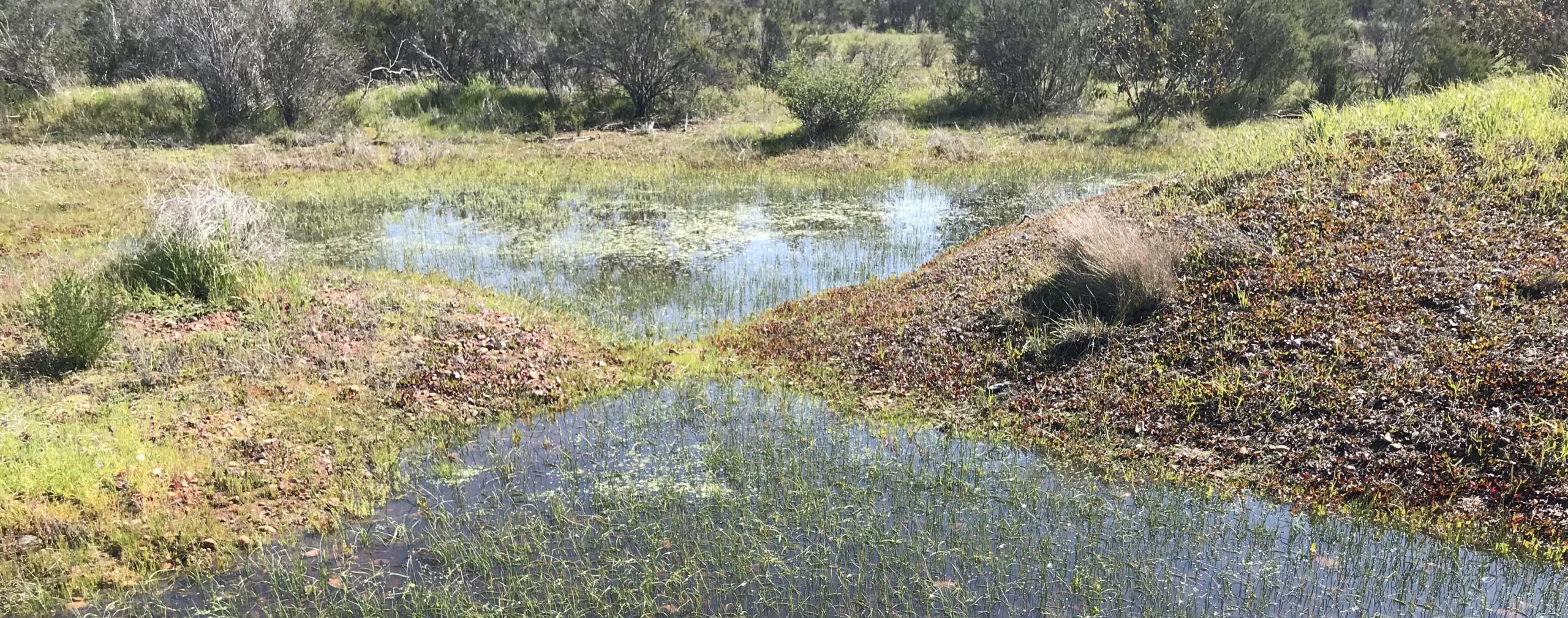VERNAL POOLS: CALIFORNIA FAIRY SHRIMP (BRANCHIOPODS)

Status: Federally & CA State Threatened / Endangered
Recovery Permit Required for Surveys? Yes
USFWS Protocol Surveys Required? Yes
Range: All of California
List of Sensitive California Fairy Shrimp Species:
- Branchinecta conservatio; Conservancy fairy shrimp (endangered)
- Branchinecta longiantenna; Longhorn fairy shrimp (endangered)
- Branchinecta lynchi; Vernal pool fairy shrimp (threatened)
- Branchinecta sandiegonensis; San Diego fairy shrimp (endangered)
- Lepidurus packardi; Vernal pool tadpole shrimp (endangered)
- Streptocephalus woottoni; Riverside fairy shrimp (endangered)
Chez Brungraber of SummitWest has a USFWS recovery permit to conduct protocol surveys presence/absence of all listed species in the state of California. She also holds the permit for dry season surveys, which consist of cyst culturing and raising. Both surveys are typically required by USFWS for projects. Learn more here about our dry & wet season fairy shrimp survey services.
Per the Vernal Pool Association, a vernal pool is “a contained basin depression lacking a permanent above ground outlet” (Vernal Pool Association 2002). More than 90% of California’s vernal pools have already been lost, making them very special and highly protected habitats. (Science Direct). Numerous rare plants, such as Eryngium aristulatum var. parishii and Pogogyne abramsii, are found in vernal pools.
To learn more about SummitWest’s dry and wet season survey capabilities, please click here.
SUITABLE HABITAT
Although there are many types of seasonally inundated wetlands, vernal pools are special in that they have a clay lens layer, which prevents water from being absorbed into the ground quickly, allowing for ponding. But unlike a wetland, they do not support typical hydrophytic vegetation and do not have an inflow/outflow of water except during high rain events. Really, they are glorified puddles that evaporate rather than drain or absorb. According to the USFWS, vernal pools “are so named for their endemic floras (e.g., Downingia sp., Eryngium sp., Plagiobothrys sp., Psilocarphus ssp.) Vernal pools are typically classified by the local geology and usually have clay soils (cite: (Zedler 1987, CDFW 1998).) Vernal pools may occur singly, but more typically occur in vernal pool complexes, due to local hydrology, geology, and topography. In an intact vernal pool, the first few rains of the season wet the surface, sometimes ponding water for a few hours to days before percolating into the subsoil ” (USFWS protocol).
WHY ARE VERNAL POOLS SO SPECIAL?
In California, vernal pools are unique and ecologically significant seasonal wetland habitats. They are temporary bodies of water that form during the rainy season and typically dry out during the summer months. Vernal pools are shallow depressions in the landscape that fill with water from rainfall and runoff, creating a distinct and specialized ecosystem.
SummitWest has vernal pool experts on staff who can map vernal pool boundaries, identify flora and fauna, and perform both wet and dry season protocol-level surveys for endangered fairy shrimp (read more here)
Here’s why vernal pools matter:
- Biodiversity Hotspots: Vernal pools support a high level of biodiversity and are home to numerous plant and animal species, many of which are specially adapted to these unique habitats. They provide critical breeding and foraging grounds for various species, including endemic and rare plant species, fairy shrimp, tadpole shrimp, and vernal pool crustaceans.
- Rare and Endangered Species: Vernal pools in California are known to harbor several rare and endangered species. For example, the federally threatened vernal pool fairy shrimp and the endangered California tiger salamander are dependent on these specialized habitats for their survival. Protecting vernal pools is crucial for the conservation of these vulnerable species.
- Plant Diversity: Vernal pools support a rich array of plant species, including native grasses, wildflowers, and small herbs. Many of these plants have adapted to the unique hydrological patterns and soil characteristics of vernal pools. Some vernal pool plant species have evolved to germinate, grow, flower, and set seed within the short window of time when the pools are filled with water.
- Ecosystem Services: Vernal pools contribute important ecosystem services. They act as natural sponges, temporarily storing rainwater, which helps recharge groundwater and prevent flooding downstream. Additionally, vernal pools provide filtration and purification of water, contributing to improved water quality.
- Cultural and Educational Value: Vernal pools hold cultural significance for indigenous communities in California. They are often associated with traditional practices, rituals, and medicinal plant use. Moreover, vernal pools serve as living classrooms, offering valuable opportunities for scientific research, ecological education, and appreciation of California’s natural heritage.
Due to their ecological importance and vulnerability to various threats, including habitat destruction, urban development, and invasive species, vernal pools are protected under state and federal regulations. Activities that may impact vernal pools or their associated species often require permits and mitigation measures to ensure their conservation.
Conserving and restoring vernal pools is essential to safeguarding the unique biodiversity they support and maintaining the ecological balance of California’s diverse landscapes. SummitWest has experts skilled at collaborating with scientists, landowners, regulators, and the community to ensure the long-term survival of these vital habitats.
CALIFORNIA FAIRY SHRIMP CHARACTERISTICS
Since not everyone recalls what sea monkeys are, according to the USFWS protocol, “Branchiopods are small crustaceans of the class (or subclass) Branchiopoda, having flattened, foot-like or paddle-like appendages that are used for locomotion, filter feeding, and respiration. Includes fairy shrimp, tadpole shrimp, and clam shrimp” (USFWS protocol)
SURVEY SEASON & GUIDELINES
Per the USFWS listed fairy shrimp survey guidelines, a complete survey consists of one wet season survey and one dry season survey, conducted and completed in accordance with these guidelines and conducted within a 3- year period
“Wet Season:
Surveyors should visit sites after initial storm events to determine when known or potential listed large branchiopod habitat has become inundated. Appropriate habitat is considered to be inundated when it holds greater than 3 cm of standing water 24 hours after a rain event.
Surveys will continue every 7 to 14 days, for 90 to 120 days or until the pool dries, depending on the location of the pools in the state of California. If pools dry and are re-inundated, surveys will commence anew.
Dry Season:
Soil (substrate) shall be collected when it is dry to avoid damaging or destroying listed large branchiopod eggs (also known as cysts or resting eggs). A hand spade or similar instrument shall be used to collect the sample at each feature taking from the top 1-3 cm of pool sediment.
The collected cysts will be cultured and processed, and then hatched under simulated conditions, at which point the fairy shrimp can be identified by the biologist.
Only biologists who hold a valid 10(a)1(A) recovery permit for the listed large branchiopods with additional terms and conditions included in their permit specifically for conducting processing, isolating, and identifying listed large branchiopod eggs are authorized to conduct this procedure.”

